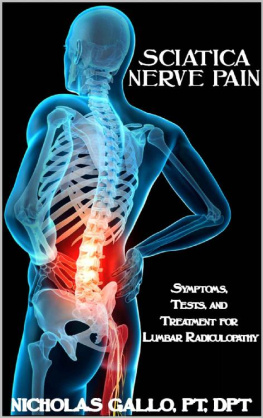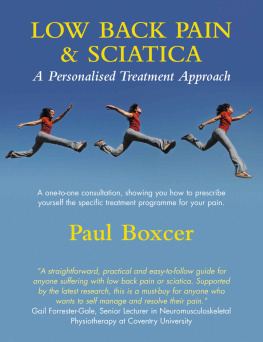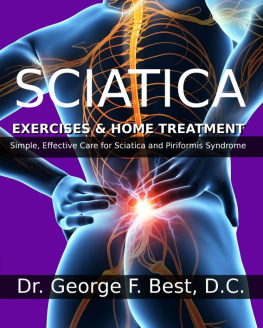The contents of this book are based on my personal experiences as a Board Certified Physical Therapist and are for informational purposes only. This book does not constitute medical advice; the content of this book is not intended to be a substitute for professional medical advice, diagnosis, or treatment. Always seek the advice of a physician or other qualified health provider with any questions you may have regarding a medical condition. Never disregard professional medical advice or delay in seeking it because of something you have read on this website. Reliance on any information provided by this book is solely at your own risk.
INTRODUCTION
Sciatica nerve pain can be debilitating and very frustrating. It can become life-changing, and the pain and discomfort can make people feel helpless. The available treatments range from conservative management to surgical management. In my experience, a person with sciatica nerve pain can be treated conservatively with physical therapy exercises and achieve great outcomes. Dont just take my word for it, though; let me cite some research for you. In a study by Boote et al., they cited research stating that surgery generates improved outcomes in the short term, but at 1 year, outcomes are very similar in both physiotherapy and surgical groups. What is the significance of this, you ask? It means that, although surgical options may provide great short-term relief, similar (if not the same) results can be achieved without surgery. This is a pretty significant finding because some patients think that surgery is their only option for relief.
Typically, sciatica nerve pain can be treated via stretching, strengthening, and sciatic nerve mobilizations. What I find most often is that people do not know which things to perform and/or how to perform them correctly. Therefore, for each treatment I talk about, I will go into detail on how to perform them correctly and why it works. I will also go into detail on specific positions and postures to avoid so that you can decrease the amount of pain you are in. Finally, I will include specific sleeping positions and other clinically proven methods that can help relieve this pain experienced by so many people. By using this step-by-step systematic approach, it is my goal that you begin to experience relief and get back to your normal routine.
Therefore, in this publication I will outline effective conservative treatment options for sciatica nerve pain that are proven in the research community. I have personally applied these treatment options when working with individuals with this condition in my experience as a board-certified doctor of physical therapy. I have personally seen the benefits of these methods, and I want to make them more well known amongst people suffering from this condition.
I also have a variety of free educational videos showing a variety of different treatments and diagnoses on my YouTube channel Physical Therapy 101 . This channel was started to provide free, to-the-point exercises to patients and practitioners. This channel is continuously being updated and provides a slew of information spanning several diagnoses including sciatica, so please subscribe if you are interested. Supplemental information can be found on my website . I will email you directly with new publications and videos I publish as soon as they come out so that you have exclusive access to them.
WHAT IS SCIATICA?
First off, lets go over what sciatica is. The term sciatica is defined as pain along the course of the sciatic nerve or its branches. You may be asking yourself, Now, what is the sciatic nerve? The sciatic nerve is a large nerve that begins in the lower back and extends down the buttock and lower limb. Therefore, sciatica nerve pain is characterized by pain that originates in the lower back and extends down the lower limb along the nerve distribution.
The sciatic nerve is massive. During cadaver lab in graduate school we dissected this area so that we could visualize it. It is significant to see its size and location because of where it is found anatomically. It passes directly under a muscle known as the piriformis. Ill go into further detail later about why this muscle is important, but know that this muscle can play a major role in why a person is feeling their symptoms.
As the sciatic nerve passes through this muscle, it extends down the rest of the lower extremity into several branches and provides innervation to the rest of the leg. I wont go into any more boring anatomy details. However, I am explaining this because this is why people with sciatica flare-ups may feel pain extending down their lower extremity.
WHERE IS SCIATICA
PAIN COMMONLY FELT?
Building more on this point, I want to go into detail on where specifically a person may feel sciatica pain. Commonly, patients experience sciatica nerve pain in their gluteal region and it can move down the back of their thigh. Due to the extensions of the nerve further down the leg, it is not abnormal to also feel pain and discomfort extending into the lower leg and/or foot. When I say pain or discomfort, I want you to know this can vary depending on the individual. I have heard all of the following descriptions for a persons sciatica: dull ache, sharp pain, burning sensations, numbness, tingling, and electric shock pain. Just know that if you are feeling one of those types of pains and it is following the nerve pathway, this is consistent with sciatica.
Sciatica nerve pain may also result in the decreased power, sensation, and reflexes in these areas. Sometimes people will feel weakness in their lower limb and say that one side feels weaker than the other. The best way to confirm these symptoms is by seeing a healthcare practitioner and having a proper evaluation.
WHAT CAUSES SCIATICA?
There are a few things that can lead to sciatica nerve pain. Common causes include: herniated disc, spinal stenosis, and entrapment of the sciatic nerve. All three of these may result in compression and/or irritation of the sciatic nerve and lead to the symptoms I listed before. It is important to know that the sciatic nerve in this case is considered the victim, and the underlying condition causing the irritation is known as the culprit. I like to typically outline to patients what is causing their discomfort and which structures are affected. In this case, the structure being affected is the sciatic nerve, and the underlying condition is something causing the irritation. Other possible causes, although rare, include tumors and other abnormal growths. Therefore, it is imperative to get these rarities ruled out before proceeding with a treatment plan.
Now, I want to be clear at this point: just because an MRI shows that you have a spine abnormality, it does NOT necessarily mean that you are symptomatic. Brinjikji et al. performed a systematic review where they looked at MRIs for over 3,000 people who did not experience lower back symptoms. What they found was that approximately 30% of those 20 years of age had some type of disc-related pathology, and this number increased with age. Also, approximately 37% of those 20 years of age also had disc degeneration in their MRI results. You may ask yourself, Now, why are they not symptomatic with these findings? That is because imaging results do not always dictate how a person presents. I have seen this time and again while treating individuals over the years. Just because the imaging shows a disc pathology, this absolutely does not mean that you are doomed.










